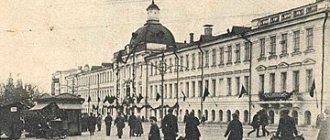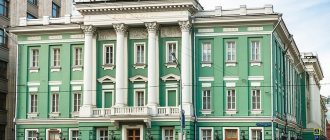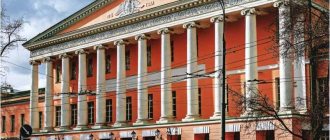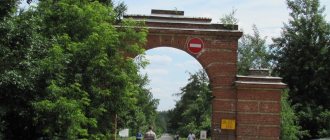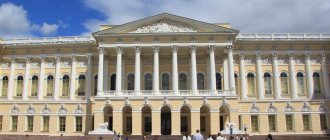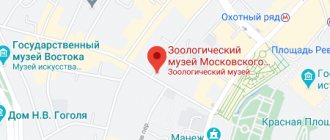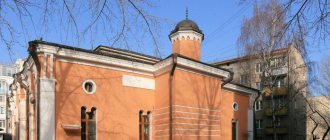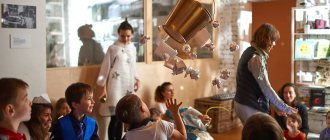The building at Bolshaya Lubyanka, building 2 has instilled terror in people for many centuries. Under Peter I there was a Secret Chancellery, under Catherine II there was a Secret Investigation Expedition. And with the Bolsheviks coming to power, they tried to bypass the Lubyanka altogether.
The former Gosstrakh building on Lubyanka in the USSR was called Gosuzhas. The reason for this was the location within its walls of the Lubyanka prison and the Cheka, and subsequently the OGPU, the NKVD, and the KGB. So why were there rumors around this building, one worse than the other?
Mental oppression system
From the instructions for managing the internal (secret) prison of the affairs management of the special department of the Cheka, approved on March 29, 1920: “The internal (secret) prison is intended to detain the most important counter-revolutionaries and spies while their cases are being investigated, or when, for well-known reasons, it is necessary to completely cut off the arrested person from the outside world, to conceal his whereabouts, to absolutely deprive him of the opportunity to communicate with his will in any way, to escape, etc.”
The bag-shaped building of the inner prison at the top ends in a rectangle of sky instead of a ceiling. It was an exercise yard, divided by blind partitions into six equal areas. Being here, not hearing the city roar, not seeing anything but the sky and walls, it’s hard to believe that you are in the center of a metropolis and under your feet is not the ground, but a flat roof and six floors of a prison below.
The prisoners were lifted here in a freight elevator that moved deliberately for a long time and with a deafening clanging, or they were led along gloomy flights of stairs - as if from the underworld, upward, towards the sun.
The huge opening in the middle, between the stairs, was covered with wire mesh - to prevent prisoners from trying to commit suicide by throwing themselves down onto the concrete floor.
Yagoda, Yezhov and Lubyanka Marshal Lavrentiy Beria had a system of oppressing the psyche of prisoners, which made them compliant. Surviving documents indicate that they personally gave orders which of the prisoners should be taken out for a walk along the stairs, and which, just to make matters worse, should be taken up in the elevator.
Thus, from a hoax, the myth of the “Lubyanka cellars” was born. A myth that was passed down from generation to generation during the Soviet years.
Another prison trick. Cell numbers were assigned not in order, but randomly, and the prisoners could not find out not only their total number, but even determine the location of their dungeon. In 1983, during Andropov's brief reign, when cells began to be converted into offices, several internal walls had to be broken down. It turned out that they all had empty cavities inside. Thus, the prisoners were deprived of their eternal privilege - the opportunity to knock with each other using the “prison telegraph”.
There have never been any escapes from here.
In the six museum chambers, left untouched for the edification of future generations, there is an imperishable smell of carbolic acid, ladle, dirty linen and sour cabbage soup.
The oppressive silence concealed the numbness, horror and despair of those who awaited their fate here.
Here you begin to believe that stone walls have energy-informational memory...
LEGENDS AND MYTHS OF LUBYANKA
The main attraction and calling card of Lubyanka is the monumental old FSB building. This powerful organization has changed its name more than once and, like the legendary building itself, has acquired many rumors and legends. Foreigners enthusiastically listen to the guide’s stories about thousands of people tortured in dungeons, and Russians, out of habit, glance warily at the gray hulk, calling it “cursed house” or “state horror” behind its back. The history of the “Big House”, which has become a legend, is known to few, but it is no less colorful than the chronicle of domestic special services.
BLOODY MEMORY OF A PLACE
The territory between Lubyanka Square and the Sretensky Gate has been known since the 12th century under the name of Kuchkov Field and is associated with the name of the rebellious boyar Kuchka, who met Grand Duke Yuri Dolgoruky “very proudly and unfriendly,” for which he was put to death. So the first mention of Moscow followed the execution, and the severed head of the boyar fell on the site of the future capital. Old-timers assure: the shadow of the proud boyar still wanders the streets and alleys of Lubyanka. From time to time, strange “ball lightning flying straight out of the ground” is observed here. Since then, this place has been ominous and frightening.
Historians still argue about the name Lubyanka. According to legend, after the forced annexation of Novgorod, in order to destroy the overly independent spirit of the Novgorodians, Ivan III resettled more than three hundred of the most noble Novgorod families to Moscow, to the territory of the current Lubyanka quarter. In memory of their hometown, where Lubyanitsa Street was located, the settlers brought this name to the capital.
Here, during the Time of Troubles, the militia of Prince Pozharsky gave two victorious battles to the Polish invaders.
A lot of blood was shed, but they forever forgot the way to us. 200 years later, on the site of the courtyard of Prince Pozharsky, the estate of the Moscow Governor-General Count F.V. Rostopchin was located. In 1812, on the day of the abandonment of Moscow, the innocent young man Vereshchagin was torn to pieces by a brutal crowd. The count was frightened by the crowd gathered in front of his house and turned the switch, sacrificing an innocent man. While the crowd was dealing with the victim, the mayor ran away from the back porch.
In 1662, Lubyanka became the epicenter of the Copper Riot. The uprising was brutally suppressed, and 30 instigators of the riot were executed on Lubyanka Square - retribution overtook the rioters in the same place where they had done wrong. Again blood was shed at this place.
On Lubyanka, at the Varsonofevsky Monastery, a “poor” cemetery was built, where the rootless, the beggars and suicides were buried. In the basement of the “dead” barn, a deep pit with ice was built, where the bodies of the unknown dead were placed. Twice a year a priest came, served a memorial service for all the dead, and they were buried together in a common grave.
On the corner of Kuznetsky Bridge and Bolshaya Lubyanka in the 18th century. The huge possession of Saltychikha, the “tormentor and murderer”, who tortured up to one and a half hundred serfs, began. In the depths of the courtyard stood her dungeon house, guarded by fierce guards and hungry dogs. She usually began to “punish” the yard girls herself, beating her with a rolling pin, sticks, logs, or a hot iron. Then, on her orders, the grooms beat the offender with whips and whips. In cases of special frenzy, she starved them, tied naked girls in the cold, doused them with boiling water, and tortured them with hot tongs. “A freak of the human race,” wrote Catherine the Great at Saltychikha’s verdict.
After the trial and imprisonment of Saltychikha in the Ivanovo Monastery, this blood-drenched possession wandered from hand to hand until it passed to Doctor Haaz, who became famous for his mercy towards the poor. For a quarter of a century, the holy doctor “bleached” this land, atonement for someone else’s crime.
Rumor has it that Saltychikha’s countless treasures are hidden in the Lubyanka cellars. Today the site of the legendary estate is the property of the FSB.
EYES AND EARS OF THE REGIME
On the corner of Myasnitskaya and Lubyanka was located the terrible brainchild of Peter I - the Secret Chancellery. In 1762, the reigning Catherine II established the Secret Expedition, which was located here at the beginning of Myasnitskaya.
Detective master Stepan Ivanovich Sheshkovsky was appointed chief secretary of the Secret Expedition. They feared him and hated him fiercely, calling him “ubiquitous” behind his back. He created such an agent network that he could report to Catherine at any hour about the actions and plans of her subjects. The chief secretary was escorted through dark secret passages to the empress’s personal apartments, where she listened to his report. Catherine, with all her tolerance, sometimes lost her temper when she heard gossip about her person from Sheshkovsky. She even issued a special “Decree on not talking too much,” in which it was strictly forbidden to spread rumors that “discredited the honor and dignity” of the empress. But sometimes even this did not help curb tongues. And then Catherine sent for Sheshkovsky.
He created a whole system of interrogation with bias, about which horrors were told. Everyone was afraid of Stepan Ivanovich’s “polite” voice: talkers and society ladies, liberals and gamblers, masons and debtors. Everyone had sins and everyone believed that Sheshkovsky knew about these sins. They said that even high society ladies tried the whip from his hands for gossip. The chief secretary carried out the interrogation in a room filled with icons, and during groans and soul-tearing screams, he read prayers. Evil tongues whispered that for bribes he was exempt from punishment and in this way acquired several houses in both capitals. He ordered the construction of basements and torture chambers in these buildings.
Rumor had it that in the office of the “omnipresent” there was a chair of a special device. As soon as the guest sat down in it, the secret mechanism latched, and the prisoner could not free himself. At Sheshkovsky’s sign, the chair lowered to the floor. Only the head and shoulders of the culprit remained above, and the rest of the body hung under the floor. There the servants took away the chair, exposed the punished parts and flogged him diligently. The performers did not see who was being punished. It all ended quietly and without publicity. Not a single nobleman dared to complain to the empress, because to do this he would have to admit that he was flogged like the last man. After such a humiliating execution, the guest laid out everything that the chief secretary required.
But there was a man who managed to take revenge for his insulted honor. He forced Sheshkovsky into a terrible chair, slammed it, and the chair and its owner collapsed. The servants were accustomed to heartbreaking screams, and did their job with “honor.” The rumor about the embarrassment of the “omnipresent” spread throughout Russia. Superstitious Muscovites assured that the underground spirits of Moscow, annoyed by the atrocities of the formidable nobleman, took revenge on him for the innocently shed blood.
LUBYANSKY PERFUME
Shortly before the revolution, the famous archaeologist Stelletsky carried out excavations in the basement of the Church of the Grebnevskaya Mother of God, which stood on Lubyanka Square, and discovered an underground gallery and white-stone secret passages there. Under the stone floors, walled up brick crypts, coffins, women's wigs, a silk shroud, shoes and a golden cross were found. Under the top row of burials from the 18th century. discovered two more levels of graves (XVII and XVI centuries).
The king of reporting, Gilyarovsky, said that during the demolition of the “house of horrors” at the beginning of the 20th century. Gloomy cellars with skeletons in chains opened up, and in the walls there were stone bags with the remains of prisoners. An underground passage clogged with earth led him to one of the Prisons of the Secret Order, where dungeons and torture chambers were discovered. Arches, rings, hooks. When they were tortured with passion in these dungeons, the screams of the unfortunate people reached the Kremlin. At night, Muscovites saw some luminous reflections on the walls of the building. Experts explained that it was the spirits of the prison, unable to withstand the suffering of people, who came out. It was rumored that at night ghosts of tortured and secretly buried prisoners could be seen here.
The temple was demolished hastily, at night, timing its death to coincide with May 1, 1935, exactly on Walpurgis Night. Mine No. 14 of Mosmetrostroy passed through the dungeon of the church. Underground passages to the basements of the Lubyanka (including the legendary building of the security officers) were discovered. During the construction of an underground KGB garage not far from the place where the church stood, two secret passages were found, lined with white stone, stone bags and torture chambers. In the 1980s, a huge building for the KGB Computer Center was built on the site of the temple. The center's security guards have repeatedly complained about incomprehensible midnight sounds coming as if from underground, and inexplicable luminous reflections in the labyrinth of Lubyanka cellars.
According to folk legends, with each new move of a formidable institution, old ghosts and spirits moved after them. It was rumored that a special type of evil spirit had evolved that not only responded to the groans and cries of the martyrs, but also gained strength from their sounds. After the old building was demolished, the spirits “screaming and groaning” moved into the neighboring building of the Cheka-GPU. Although the security officers loudly declared that they did not believe in any devilry, and at night they sometimes shuddered from the groans coming from the basements. They tell how “little People’s Commissar” Nikolai Yezhov, hearing suspicious rustling noises at night, fired a revolver into the dark corners of his office. When Yezhov was arrested, they found bullet holes in the floor and walls of the office.
The famous security officer Genrikh Yagoda was a fierce enemy of superstitions and “mystical dope,” however, according to rumors, he also fought the “Lubyanka spirits,” secretly from his subordinates splashing his own poison on the floor and walls of his offices. Back in 1933-1934, Yagoda, a former pharmacist, organized a secret laboratory in the depths of the OGPU-NKVD for the production of poisons to eliminate “enemies of the people”, first abroad and then within the country. At Lubyanka, special poisons were created that led to instant or rapid death with imitation of the symptoms of other diseases. It was rumored that a few hours before his arrest he suddenly heard a mysterious quiet voice: “Break your bottles, you won’t need them anymore.” After his arrest, many glass shards were found in his office.
Lavrentiy Beria proved himself to be an unbending atheist. Mysterious moans, sighs and rustling noises did not bother the new People's Commissar. In such cases, he began to read poetry or sing loudly. And with General Viktor Avakumov, the Lubyanka evil spirits established familiar relations. He loved to drink alone in his office at night and always left an unfinished bottle of vodka or cognac on the cabinet. In the morning this bottle, of course, was empty.
In the famous house on Lubyanka, inexplicable strange phenomena are still observed today: strange shadows crawl along the walls, the phone rings in a voice that is not one’s own, or business papers suddenly end up in the wrong folder. Employees who have retired to the reserve tell in secret how some of their former colleagues secretly sprayed their office “in all four corners” with alcoholic drinks or holy water: just in case.
GOSS FEAR OR GOSUZZHAS?
In March 1918, the Cheka together with the government moved from revolutionary St. Petersburg to Moscow. Soon the word “Lubyanka” acquired an ominous sound. The faithful guards of the revolution - the security officers - moved into the building of the former insurance company (SO) "Anchor" on Bolshaya Lubyanka, 11. Here, on the 2nd floor, there was the office of its first chairman - F.E. Dzerzhinsky, in which there was a huge, heavy-duty steel safe. It still stands in the same place. One day, the hard work of the first security officer was interrupted by a hand grenade suddenly flying into the window. Dzerzhinsky quickly jumped out from behind the table and instantly disappeared into a metal safe. The explosion that followed broke glass and damaged furniture and walls. But the safe did not cause any harm. According to legend, it was after this miraculous rescue that his comrades began to call their boss “the iron one.” And only later biographers substantiated this pseudonym with the iron steadfastness of a knight of the revolution.
With the light hand of the mystic security officer Gleb Bokiy, in 1920 the Cheka and later the KGB settled in Moscow on Lubyanka Square in the building of the former Rossiya insurance company. Here, in a former hotel, hidden in the depths of the courtyard, is located the famous “Nutryanka” - the Internal Prison of the Cheka-OGPU-NKVD. Muscovites began to carelessly joke: “There was Gosstrakh, but now it’s State Horror.” The building, which previously belonged to the Rossiya Society, kept all of Russia in fear.
By the end of the 20s, the security officers became crowded within the walls of the legendary house, and the building was reconstructed. Directly behind it, on the side of Furkasovsky Lane, a new building was built, shaped like the letter W in plan, as if saying “Sha!” to everyone who came here. The Inner Prison was also reconstructed - 4 more floors were added to it. The architect solved the problem of prisoners walking in an original way, by arranging six exercise yards with high walls right on the roof of the building. Prisoners were brought here in special elevators.
In Moscow in the 1930s, oddly enough, they continued to joke. For example, like this: “Which building is the tallest in Moscow? Answer: Lubyanskaya Square, 2. From its roof you can see Kolyma.”
In the neighboring outbuildings there were Gusenkov's tavern and Generalov's store, famous for its freshest products. They say that subsequently the investigators devoured sandwiches with black caviar and ham in front of the hungry interrogators, swearing to them that all they had to do was sign everything, and they would bring them the same things.
In 1940-1947, the security officers again became cramped, and another reconstruction began according to the design of the venerable architect, creator of the Lenin Mausoleum A.V. Shchusev.
In 1961, the Inner Prison ceased to exist. The last prisoner seen by its walls was the American spy pilot Harry Francis Powers. Then part of the prison was converted into a canteen, and the remaining cells were made into offices for KGB officers. At the end of the Andropov era, Lubyanka Square was finally taking shape. On the left, on the site of the bloody Saltychikha estate, a new monumental building of the KGB of the USSR was built, where the leadership of the department moved. And on the right - the KGB CC has grown.
In 1926, immediately after the death of F.E. Dzerzhinsky, the square and Bolshaya Lubyanka Street were renamed in his honor. In 1958, at the height of the “thaw,” a monument to Dzerzhinsky was erected in the center of the square named after the first security officer. The monument stood for exactly 30 years and 3 years - in August 1991 it was overthrown to the jubilation of the crowd. Now he stands on Krymsky Val, surrounded by defeated comrades. The square was returned to its old name - Lubyanskaya.
In the next issue of “Through the Looking Glass” we will talk about the terrible secrets of the Lubyanka, the labyrinth of “horror and blood” and the mystery of the death of “Iron Felix”.
* * *
The “internal” regime differed significantly from the conditions of ordinary prisons. It was not allowed to receive information from outside or transmit any information from prison. The defendants were strictly prohibited from corresponding with relatives and reading the latest newspapers and magazines. Except for specially permitted cases, the use of writing instruments was prohibited.
Contrary to popular belief, no one was beaten or tortured in the cells. The bodies and souls of those under investigation were mutilated during interrogations, which were conducted in investigators' offices, where there were only tables and stools tightly screwed to the floor. Special tools were not used to obtain a confession from the person under investigation - as was the case in the dungeons of the Gestapo. Assault and torture with insomnia were common.
This is when alternate investigators interrogate you for several days in a row with breaks for short, no more than an hour, sleep. After three days of intense interrogation, in the intervals between which you fall into a state of restless oblivion, and the sense of time is lost. The line between nightmare reality and the horror of dreams, more similar to hallucinations, is completely erased. An all-encompassing, oppressive fear appears, turning into panic. After another two days, deprived of proper sleep, you can no longer navigate not only in time, but also in space, as if moving into the virtual world. And then... Then you will agree to everything, just to find yourself again and find yourself in the real world!
The arrestees were led to the investigators by guards while the prison keys jingled in time with each step. This accompaniment is not an accidental attribute of prison life. Hearing him in the corridor or on the stairs, one of the guards turned his prisoner to face the wall or pushed him into a specially equipped box and waited until he was escorted past the oncoming prisoner. There were cases when a wife going for interrogation passed by her husband standing in a box and they could not recognize each other.
Repressed elite
Today, only documents preserved in the legal department of the FSB can impartially tell about the conditions of detention of prisoners in an internal prison, about the laws and morals that reigned there. For example, the registration log of prisoners of the Lubyanka (internal) prison for 1937.
This is a thick, five-hundred-sheet case with cardboard covers that look like gray-brown marble with red veins. The reddish-brown web can be compared to streaks of blood caked on a prison floor.
From the register of prisoners of the internal prison for 1937
Arrested No. 365 Bukharin Nikolai Ivanovich, 1888–1938. (There is no mark on the photograph. Apparently, there was no need for this - everyone knew the editors of Pravda and Izvestia.) Arrived on February 28, 1937, left for Lefortovo on March 14, 1938.
Arrested No. 1615 Rudzutak Jan Ernestovich, 1887–1938. (participant in the revolution of 1905–1907 in Riga, revolution of 1917 in Moscow, People's Commissar of Railways, General Secretary of the All-Union Central Council of Trade Unions). Arrived on September 5, departed on October 5, 1937 to Lefortovo prison.
Arrested No. 2068 Tupolev Andrey Nikolaevich, 1888–1972. (outstanding Soviet aircraft designer, future academician of the USSR Academy of Sciences, three times Hero of Socialist Labor, laureate of the Lenin and State Prizes. He was in Lubyanka prison twice: from October 23, 1937 to October 8, 1938 and from January 18 to June 17, 1939. ). Left for Butyrka prison.
Arrested No. 2631 Vatsetis Joachim Joakimovich, 1873–1938. (commander of the 2nd rank, during the Civil War - commander in chief of the Armed Forces of the Republic). In the “inside” from December 10, 1937 to January 9, 1938, he was sent to Lefortovo prison.
Reference:
A note in the log book about the prisoner's departure to Lefortovo or Lefortovo prison meant execution. Throughout the subsequent years of Soviet power, this was the only prison in Moscow where those sentenced to death were executed.
...In that fateful year, hundreds of people famous throughout the country ended up in the Lubyanka dungeons.
Prominent government and party figures - distributor of Iskra and organizer of the underground Baku printing house "Nina" Avel Safronovich Enukidze; Lenin’s liaison officer, who was hiding in Razliv, was Alexander Vasilievich Shotman; leader of the Hungarian and international communist movement Bela Kun...
Outstanding designers and scientists - the creator of heavy bombers, Vladimir Mikhailovich Petlyakov; author of the theory of air-rocket engines Stechkin Boris Sergeevich; founder of Soviet rocketry Sergei Pavlovich Korolev...
Writers and cultural figures - the creator of the children's theater Natalya Ilyinichna Sats, the writer of everyday life of the revolutionary era Pilnyak Boris Andreevich, playwright Kirshon Vladimir Mikhailovich...
The bars and stones of the Lubyanka prison became the lot of the Cheka-OGPU employees and their relatives. A participant in three revolutions, an employee of the Cheka from the day of its founding, Ivan Petrovich Pavlunovsky; Chief of the Intelligence Department of the Red Army Headquarters Berzin Yan Karlovich; first head of the INO OGPU RSFSR Davtyan Yakov Khristoforovich; head of foreign intelligence of the NKVD Artuzov Artur Khristianovich; resident of the INO OGPU RSFSR in Vienna Zaporozhets Ivan Vasilievich; the legendary intelligence officer Dmitry Aleksandrovich Bystroletov and many, many others.
In total, from January 1 to December 31, 1937, 2,857 people were placed in the Lubyanka prison. Everyone was interrogated, protocols were drawn up, and after a while they were handed a travel document - some to Butyrka, and some to Lefortovo, that is, to eternity. Only 24 people were allowed to go home. Although who knew for how long...
Even on the days of revolutionary holidays, the flywheel of repressions that had gained momentum did not stop. On May 1, 1937, 4 prisoners were placed in the “interior”. November 7 – 5. December 21, Stalin’s birthday, – 6 “enemies of the people.” This did not go beyond the average daily norm of the Lubyanka prison: from 2 to 20 people. When the last day of this mortally terrible year arrived, the prison, as if realizing that two dozen prisoners had been released, immediately absorbed another 24 people.
Bolshaya Lubyanka street, 1/3 on the panorama map of Moscow, organizations, detailed photos
Photo school Photo business laboratory
Photo school
Address: Pushechnaya st., 15
Telephone
Temple of Sophia the Wisdom of God
Orthodox church
Address: Pushechnaya st., 15
Opening hours: Monday – Saturday from 10:00 to 18:00; Sunday from 8:00 to 18:00
Telephone
Internet Group Cyber-ka
Information website
Address: st. Bolshaya Lubyanka, 1, building 1
Opening hours: Every day, from 10:00 to 20:00
Telephone
StroyAsphalt
Road Construction and Repair, Urban Improvement, Construction Company
Address: Pushechnaya st., 11
Opening hours: Monday – Saturday 24 hours a day
Telephone
Multilandia
Organization and holding of children's parties, Goods for the holiday, Event agency
Address: st. Kuznetsky Most, 24
Opening hours: Every day, 24 hours a day
Telephone
Center for Licensing, Certification and Protection of State Secrets of the FSB of Russia Licensing Department
Certification of products and services
Address: st. Bolshaya Lubyanka, 1/3
Working hours: Monday – Friday from 9:00 to 18:00, break from 12:00 to 13:00
Telephone
The Romanov Brothers Watch Exchange
Thrift Store, Pawn Shop, Watch Store
Address: st. Kuznetsky Most, 19, building 1
Opening hours: Monday – Friday from 11:00 to 20:00; Saturday from 11:00 to 19:00
Phones,
Yulia Prokhorova
Clothing store
Address: st. Kuznetsky Most, 19, building 1
Opening hours: Every day, from 10:00 to 22:00
Phones,
Passage Kuznetsky Most
Shopping mall
Address: st. Kuznetsky Most, 19, building 1
Opening hours: Every day, from 12:00 to 21:00
Telephone
Clock face
Coworking space, Anti-cafe, Leisure club
Address: st. Kuznetsky Most, 19, building 1
Opening hours: Monday – Thursday from 10:00 to 0:00; Friday, Saturday from 10:00 to 6:00; Sunday from 10:00 to 0:00
Telephone
Turov Island
Travel agency, Railway and air tickets
Address: st. Kuznetsky Most, 19, building 1
Opening hours: Monday – Friday from 11:00 to 19:00; Saturday from 11:00 to 15:00
Telephone
Dom.ru Wi-Fi
Wi-Fi hot spot
Address: st. Kuznetsky Most, 19
Opening hours: Every day, 24 hours a day
Telephone
Swimlike - swim products
Sports Store, Sports Goods & Equipment, Sportswear & Shoes
Address: st. Kuznetsky Most, 19, building 1
Opening hours: Every day, from 10:00 to 21:00
Phones, +7 999 842 88 49
Cafe-gelateria Plombir
Cafe
Address: Teatralny pr., 5, building 1
Phones,
Shashlykoff
Bar, pub
Address: st. Kuznetsky Most, 19, building 1
Opening hours: Monday – Thursday from 10:00 to 0:00; Friday, Saturday from 10:00 to 3:00; Sunday from 10:00 to 0:00
Telephone
Mandy's Apothecary Irish Pub
Bar, pub, restaurant
Address: st. Kuznetsky Most, 19, building 1
Working hours: Monday – Thursday from 12:00 to 0:00; Friday, Saturday from 12:00 to 3:00; Sunday from 12:00 to 0:00
Telephone
Bouquet
Perfumery and cosmetics store
Address: st. Kuznetsky Most, 19, building 1
Opening hours: Every day, from 12:00 to 20:00
Phones,
Coffee shop 1554 TsDM
Coffee Shop, Sports Bar
Address: Teatralny pr., 5, building 1
Opening hours: Monday – Thursday from 10:00 to 22:00; Friday – Sunday 24 hours a day
Clos Cafe
Cafe
Address: st. Kuznetsky Most, 19, building 1
Opening hours: Every day, from 10:00 to 23:00
Phones,
Translation agency
Translation agency, Apostille and legalization of documents
Address: st. Kuznetsky Most, 19
Opening hours: Monday – Friday from 10:00 to 17:00
Phones, +7 901 578 83 08
Apartment building of A.G. Gagarin
Sight
Address: st. Kuznetsky Most, 19, building 1
Lucky Chan
Cafe, Restaurant, Sports Bar
Address: st. Kuznetsky Most, 19, building 1
Opening hours: Monday – Thursday from 11:00 to 0:00; Friday – Sunday from 11:00 to 6:00
Telephone
IqToy
Children's toys and games
Address: Teatralny pr., 5, building 1
Opening hours: Every day, from 10:00 to 22:00
Phones, +7 495 107 90 80
Federal Security Service of Russia
State Security Service
Address: st. Bolshaya Lubyanka, 1, building 1
Opening hours: Monday – Friday from 8:00 to 17:00, break from 13:00 to 14:00
Phones, +7 495 224 22 22
kartologia.ru
* * *
There were prisoners in the “interior” who remembered the tsarist prisons, hard labor and exile. In September 1937, Maria Alexandrovna Spiridonova was taken there. A former militant, the leader of the Left Socialist Revolutionary Party, at the beginning of the century she destroyed General G.N. Luzhenosky, who suppressed peasant uprisings in the Tambov province. For this terrorist attack, the tsarist government sentenced her to hanging, but replaced the death penalty with eternal hard labor.
The October Revolution of 1917 liberated the underground. However, in 1918, Spiridonova, the inspirer of the Left Socialist Revolutionary rebellion and the murder of the German ambassador Mirbach, was again behind bars. Then an amnesty from the All-Russian Central Executive Committee and again a dungeon. In total, during the years of Soviet power, her total prison experience was 10 years in prison and 12 years in exile.
On September 11, 1941, Spiridonova was shot by verdict of the Military Collegium.
* * *
The territory is fenced with a stone wall with barbed wire. In the corners are towers with machine gunners. Pre-zone with a control strip and another barbed wire fence. Internal solid fence with barbed wire. Signaling. Shepherd dogs. TV cameras.
This is not from films about war or fascist concentration camps. This is the Kazan special psychiatric hospital (read: prison for dissident elements), where Ilyin ended up in 1970 and where he spent eighteen years of imprisonment in solitary confinement.
In the internal security, in addition to guards (civilian warrant officers), unaccompanied criminals serving sentences for serious crimes monitor the patients. Criminals are called “orderlies,” anti-Soviet activists are called “sick” or simply “fools.” After finishing their shift, the criminals - all in white jackets and white caps - watch TV, eat food taken from patients, transferred from the outside, play volleyball, go to school...
The “fools” have a strict regime - even for minor needs they are not always allowed out of their cells, they urinate in their shoe and pour it out the window.
The “orderlies” beat the “fools” for any reason, sometimes one of the medical staff watches the execution. They beat mercilessly, trying to cause the greatest damage to internal organs, especially the kidneys and liver. Goal: send every dissident who arrives for treatment with a “duck” for life...
Ilyin spent about two years in such conditions until the construction of a new building with solitary cells was completed.
The “orderlies,” having learned from the official chronicle that the admitted “patient” had attempted to kill the astronauts, arranged for him to be “tested in a pressure chamber.” This execution, like all the others, was not only agreed upon by the prison administration, but also sanctified by it.
It was explained to the subject that “testing in a pressure chamber” was carried out in order to determine his psychophysical capabilities for working as an astronaut.
The “patient” screaming obscenities, ignoring his height and build, was pushed into the bedside table by the “orderlies” and, having dragged her to the second floor, they pushed her down.
When the criminals tried to “test” Ilyin, he sank his teeth into the nose of one of the attackers and did not let him go until he had bitten off completely.
After this incident, Ilyin’s training as an astronaut went according to a different plan: real orderlies began to turn the terrorist’s buttocks into a sieve, injecting excessive doses of chlorpromazine.
Bolshaya Lubyanka street, 11с1 on the map of Moscow, organizations, photo detail
Sauna
Sauna
Address: st. Bolshaya Lubyanka, 11, building 1
Opening hours: Every day, 24 hours a day
Telephone
Under the wing
Insurance Company
Address: st. Bolshaya Lubyanka, 11, building 1
Working hours: Monday – Friday from 8:30 to 18:00
Telephone
Fire Safety Center
State supervisory authorities
Address: st. Bolshaya Lubyanka, 11, building 1
Opening hours: Monday – Friday from 9:00 to 18:00
Telephone
Girlsband
Creative team, Holiday agency
Address: Russia, Bolshaya Lubyanka street
Opening hours: Every day, from 10:00 to 20:00, break from 13:00 to 14:00
Phones,
VTB Bank, ATM
ATM
Address: st. Bolshaya Lubyanka, 16, building 1
Opening hours: Every day, 24 hours a day
Telephone
The world of whiskey and wine
Liquor store
Address: st. Bolshaya Lubyanka, 16, building 2
Opening hours: Every day, from 10:00 to 22:00
Telephone
Apartment house with restaurant A. N. Novikov
Sight
Address: st. Bolshaya Lubyanka, 16, building 2
Private security organization Emperor
Security company
Address: st. Bolshaya Lubyanka, 16, building 2
Opening hours: Monday – Friday from 9:00 to 17:00
Telephone
VSK-mortgage
Mortgage agency
Address: st. Bolshaya Lubyanka, 11A
Working hours: Monday – Friday from 9:00 to 18:00
Telephone
Ministry of Internal Affairs of the Russian Federation
Ministries, departments, public services
Address: st. Bolshaya Lubyanka, 11
Opening hours: Monday – Friday from 9:00 to 18:00
Telephone
PKU Central Club of the Ministry of Internal Affairs of Russia
Leisure club
Address: st. Bolshaya Lubyanka, 13/16с1
Opening hours: Monday – Friday from 9:30 to 18:00
Phones, +7 495 667 40 42
FGKU Center for Military Medical Expertise of the FSB of Russia
Medical Commission, State Security Service
Address: Bolshoi Kiselny per., 12, bldg. 3
Working hours: Monday – Thursday from 9:00 to 18:00, break from 12:50 to 13:50; Friday from 9:00 to 16:45, break from 12:50 to 13:50
Phones, +7 495 914 53 27
Chambers of the Makaryevsky Zheltovodsky Monastery
Sight
Address: st. Bolshaya Lubyanka, 16, building 3
Argus-Spectrum M
Security and protection systems
Address: st. Bolshaya Lubyanka, 16, building 3
Opening hours: Monday – Friday from 9:00 to 18:00
Phones, +7 499 579 80 68
Knight
Security and protection systems, Security company
Address: st. Bolshaya Lubyanka, 16, building 3
Opening hours: Every day, 24 hours a day
Telephone
Investment Bureau Finist
Investment Company, Financial Consulting
Address: st. Bolshaya Lubyanka, 16, building 3
Working hours: Monday – Friday from 10:00 to 18:00
Phones,
VSK Insurance House
Insurance Company, Car Insurance
Address: st. Bolshaya Lubyanka, 11A, building 1
Opening hours: Monday – Friday from 9:00 to 20:00; Saturday from 10:00 to 15:00
Phones, +7 495 784 77 00
Banquet holding Banquet-Partner
Banquet hall, Advertising products, Events agency
Address: st. Bolshaya Lubyanka, 13/16с1
Opening hours: Every day, from 10:00 to 23:30
Phones,
Academic Song and Dance Ensemble of the National Guard of the Russian Federation
Creative team
Address: st. Bolshaya Lubyanka, 13/16с1
Working hours: Monday – Friday from 9:00 to 18:00
Phones, +7 903 723 82 61
I Van Gogh
Restaurant, Nightclub, Wholesale wines and wine drinks
Address: st. Bolshaya Lubyanka, 13/16с1
Opening hours: Monday – Thursday from 12:00 to 0:00; Friday, Saturday from 12:00 to 6:00; Sunday from 12:00 to 0:00
Telephone
Apartment building of E. S. Tryndin
Sight
Address: st. Bolshaya Lubyanka, 13/16с1
Outbuilding of the Orlov-Denisov estate
Sight
Address: st. Bolshaya Lubyanka, 14, building 4
Chambers of Princes Khovansky
Sight
Address: st. Bolshaya Lubyanka, 7, building 3
The Bartender
Organization and servicing of exhibitions, Catering
Address: st. Bolshaya Lubyanka, 13/16с1
Opening hours: Monday – Friday from 9:00 to 21:00
Telephone
kartologia.ru
* * *
On June 12, 1988, Ilyin was transported from the Kazan special psychiatric hospital to Lubyanka, where he communicated for three hours with the leaders of the Investigation Department of the KGB of the USSR. After signing the relevant papers, the last prisoner of the “interior” was released on all four sides.
With the execution of Beria, the golden age of the “interior” ended. By December 1953, out of 570 beds, only 170 were occupied, and on January 1 of the following year, only 97 people were kept in the Lubyanka prison.
During the years of Gorbachev's perestroika, when the movement from developed socialism to underdeveloped democracy began, six cells of the Lubyanka prison, this attribute of the camp-socialist statehood, following the highest order of the Politburo of the CPSU Central Committee, were turned into a museum. Since December 1989, it has been open to visitors with security clearance...
Basement under an ancient building on the corner of Malaya Lubyanka and Furkasovsky Lane. Some time ago, the basement was in a semi-abandoned state, the entrance was closed purely symbolically, and a homeless person lived inside. Subsequently, the basements were taken over, reconstruction began there, and now they are no longer accessible. The photographs were taken at the very beginning of reconstruction, when lighting had just been installed there and work began on clearing debris.
Bolshaya Lubyanka 2 - Myasnitskaya 1 - Main building of the KGB-FSB
The current KGB-FSB building, facing Lubyanka Square and located at Myasnitskaya, building 1 and Bolshaya Lubyanka, building 2, appeared on this site by merging two different apartment buildings of an insurance company with the name “Russia”.
The first five-story building, which was located on the Bolshaya Lubyanka side, was built between 1897 and 1898. The author of the project was the architect N.M. Proskurin.
The second building, located closer to Myasnitskaya Street, was built between 1897 and 1900. Architects - A.V. Ivanov (known as the author of the Moscow hotels “National” and “Balchug”) and N.M. Proskurin. The height of the building is 4 floors.
The location and decoration of both buildings attracted wealthy tenants to this area, who were not afraid of high rental prices, which sometimes exceeded 2-3 times the cost of identical apartments in the center of Moscow.
History of the KGB building on Lubyanka Square
In December 1919, the Cheka, which had previously occupied premises at 11 Bolshaya Lubyanka since the spring of 1918, was located in the buildings of the Rossiya society, which had been liquidated by that time, at 2 Bolshaya Lubyanka and 1 Myasnitskaya Street.
Also, a nearby building on Furkasovsky Lane, in which the notorious internal prison was built, comes under the jurisdiction of Dzerzhinsky.
The five-story building of the former Rossiya society has increased by two floors, and a building made in the constructivist style, designed by architects Arkady Langman and Igor Bezrukov, is being added to its rear facade. The number of floors in the internal prison was increased to six, instead of the previous two.
The next reconstruction of the buildings took place on the initiative of the former head of the NKVD Lavrentiy Beria.
The project, approved in 1940 and executed by architect A.V. Shchusev, it was intended to combine the former apartment buildings of “Russia” with the construction of a single main facade. The section of Malaya Lubyanka Street facing Lubyanka Square was supposed to become part of the courtyard.
Due to the outbreak of the 1941-1945 war, the project was implemented only by 1947. True, the “Russia” house on the side of Bolshaya Lubyanka, 2 was left in its original form, already built on two floors, until 1983. Then the building was demolished, and its place was taken by the continuation of the building at Myasnitskaya, 1, reconstructed by A.V. Shchusev.
We also suggest you take a look:
Watch the video “Architectural ensemble of Myasnitskaya Street in Moscow”:
| Latest articles added to the site... |
progulkipomoskve.ru
